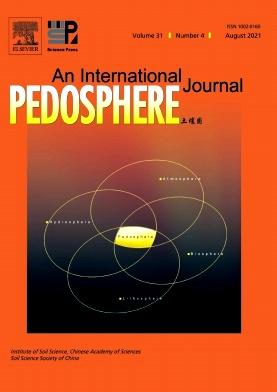农业活动造成的泥炭土变化对温室气体(特别是一氧化二氮)排放的影响及其缓解措施
IF 7.3
2区 农林科学
Q1 SOIL SCIENCE
引用次数: 0
摘要
天然泥炭地是CH4排放源,但也是CO2和N2O的汇。另一方面,排干的泥炭地抑制了CH4的排放,但成为CO2和N2O的排放源。排干的泥炭地面积占世界农业用地的2%,但其温室气体(GHG)排放量占全球温室气体排放量的7%。在土地清理后,由于氮肥的施用,N2O排放立即显著增加。此外,在长期耕作的热带泥炭地,年N2O排放量增加到700 kg N ha-1 -1。这表明一个有机物分解、硝化和反硝化的连续过程已经发展起来。另一方面,在新清理的油棕种植园中,通过适当的水肥管理,N2O和CO2排放量随着时间的推移而减少。地下水上升的毛管增加了表层的充水孔隙空间,提高了植物对氮的吸收,抑制了有机质的分解。这被认为消耗了多余的NO3——N,分解了易分解的有机物,减少了N2O的排放。进一步研究以验证其长期有效性将有助于建立可持续的泥炭地管理。本文章由计算机程序翻译,如有差异,请以英文原文为准。
Impacts of changes in peat soils due to agricultural activities on greenhouse gas (especially N2O) emissions and their mitigations
Natural peatlands are a source of CH4 emission but a sink of CO2 and N2O. On the other hand, peatlands drained for agricultural use suppress CH4 emission but become a source of CO2 and N2O emissions. Drained peatland area accounts for 2% of the world's agricultural land, but its greenhouse gas (GHG) emissions account for 7% of global GHG emissions. Immediately after land clearing, N2O emission significantly increases due to nitrogen (N) fertilization. Furthermore, in tropical peatland fields that have been cultivated for a long term, annual N2O emission increased to 700 kg N ha-1 year-1. This shows that a successive process of organic matter decomposition, nitrification, and denitrification has been developed. On the other hand, in newly cleared oil palm plantations with proper water and fertilizer managements, both N2O and CO2 emissions decreased over time. Capillary risen from groundwater could increase water-filled pore space of the top layer, improve plant N uptake, and suppress organic matter decomposition. This is thought to have consumed surplus NO3--N, decomposed easily decomposable organic matter, and reduced N2O emission. Further research to verify its effectiveness over a long term will help to create sustainable peatland management.
求助全文
通过发布文献求助,成功后即可免费获取论文全文。
去求助
来源期刊

Pedosphere
环境科学-土壤科学
CiteScore
11.70
自引率
1.80%
发文量
147
审稿时长
5.0 months
期刊介绍:
PEDOSPHERE—a peer-reviewed international journal published bimonthly in English—welcomes submissions from scientists around the world under a broad scope of topics relevant to timely, high quality original research findings, especially up-to-date achievements and advances in the entire field of soil science studies dealing with environmental science, ecology, agriculture, bioscience, geoscience, forestry, etc. It publishes mainly original research articles as well as some reviews, mini reviews, short communications and special issues.
 求助内容:
求助内容: 应助结果提醒方式:
应助结果提醒方式:


